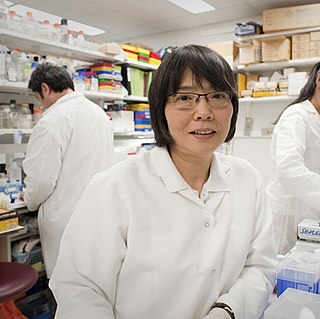Related Research Articles

A homeobox is a DNA sequence, around 180 base pairs long, found within genes that are involved in the regulation of patterns of anatomical development (morphogenesis) in animals, fungi, plants, and numerous single cell eukaryotes. Homeobox genes encode homeodomain protein products that are transcription factors sharing a characteristic protein fold structure that binds DNA to regulate expression of target genes. Homeodomain proteins regulate gene expression and cell differentiation during early embryonic development, thus mutations in homeobox genes can cause developmental disorders.
The heart is the first functional organ in a vertebrate embryo. There are 5 stages to heart development.

PDX1, also known as insulin promoter factor 1, is a transcription factor in the ParaHox gene cluster. In vertebrates, Pdx1 is necessary for pancreatic development, including β-cell maturation, and duodenal differentiation. In humans this protein is encoded by the PDX1 gene, which was formerly known as IPF1. The gene was originally identified in the clawed frog Xenopus laevis and is present widely across the evolutionary diversity of bilaterian animals, although it has been lost in evolution in arthropods and nematodes. Despite the gene name being Pdx1, there is no Pdx2 gene in most animals; single-copy Pdx1 orthologs have been identified in all mammals. Coelacanth and cartilaginous fish are, so far, the only vertebrates shown to have two Pdx genes, Pdx1 and Pdx2.

Homeobox protein Nkx-3.1, also known as NKX3-1, NKX3, BAPX2, NKX3A and NKX3.1 is a protein that in humans is encoded by the NKX3-1 gene located on chromosome 8p. NKX3-1 is a prostatic tumor suppressor gene.

NK2 homeobox 1 (NKX2-1), also known as thyroid transcription factor 1 (TTF-1), is a protein which in humans is encoded by the NKX2-1 gene.

Paired-like homeodomain transcription factor 2 also known as pituitary homeobox 2 is a protein that in humans is encoded by the PITX2 gene.

Homeobox protein Nkx-2.5 is a protein that in humans is encoded by the NKX2-5 gene.

Hematopoietically-expressed homeobox protein HHEX is a protein that in humans is encoded by the HHEX gene and also known as Proline Rich Homeodomain protein PRH.

Paired-like homeodomain 1 is a protein that in humans is encoded by the PITX1 gene.
Neurogenins are a family of bHLH transcription factors involved in specifying neuronal differentiation. It is one of many gene families related to the atonal gene in Drosophila. Other positive regulators of neuronal differentiation also expressed during early neural development include NeuroD and ASCL1.

Homeobox protein Nkx-2.2 is a protein that in humans is encoded by the NKX2-2 gene.

Homeobox protein Nkx-2.3 is a protein that in humans is encoded by the NKX2-3 gene.

NK3 homeobox 2 also known as NKX3-2 is a human gene. It is a homolog of bagpipe (bap) in Drosophila and therefore also known as Bapx1. The protein encoded by this gene is a homeodomain containing transcription factor.

Homeobox protein Nkx-6.1 is a protein that in humans is encoded by the NKX6-1 gene.

Iroquois-class homeodomain protein IRX-3, also known as Iroquois homeobox protein 3, is a protein that in humans is encoded by the IRX3 gene.

Hepatocyte nuclear factor 3-gamma (HNF-3G), also known as forkhead box protein A3 (FOXA3) or transcription factor 3G (TCF-3G) is a protein that in humans is encoded by the FOXA3 gene.
tinman, or tin is an Nk2-homeobox containing transcription factor first isolated in Drosophila flies. The human homolog is the Nkx2-5 gene. tinman is expressed in the precardiac mesoderm and is responsible for the differentiation, proliferation, and specification of cardiac progenitor cells. This gene is named after the character Tin Woodman who lacks a heart, as flies with nonfunctional tinman genes have cardiac deformities.

PBX/Knotted 1 Homeobox 2 (PKNOX2) protein belongs to the three amino acid loop extension (TALE) class of homeodomain proteins, and is encoded by PKNOX2 gene in humans. The protein regulates the transcription of other genes and affects anatomical development.

Shioko Kimura is a Japanese-American biochemist specialized in endocrinology and the physiology and pathogenesis of diseases including thyroid and lung cancers. She heads the endocrinology section in the laboratory of metabolism at the National Cancer Institute.
NK3 homeobox 3 also known as NKX3-3, zax, bagpipe homeobox or zampogna is a paralogous gene of NKX3-2. It is named after the italian instrument called zampogna. NKX3-3 is not present in the human genome.